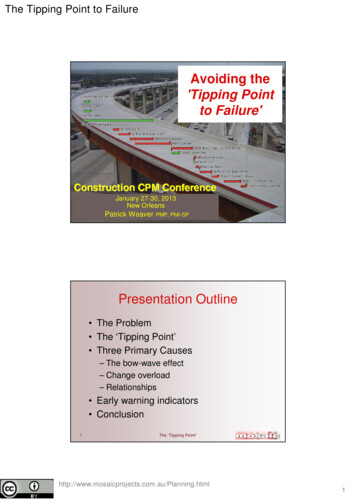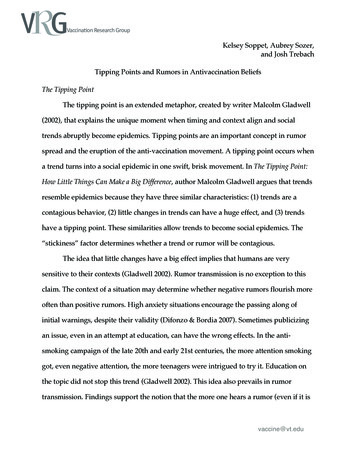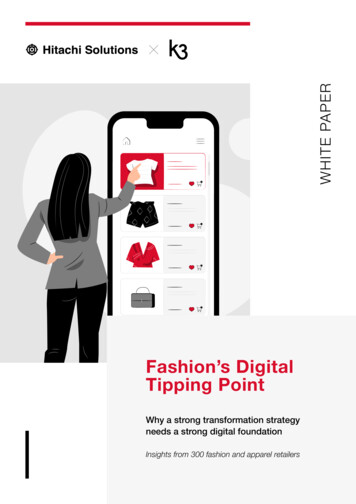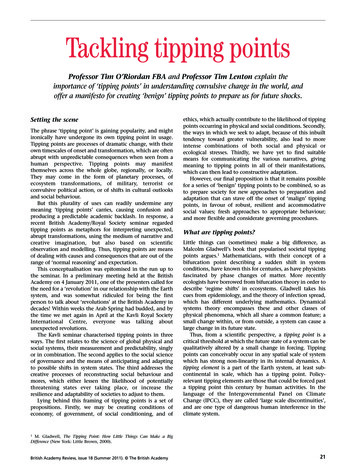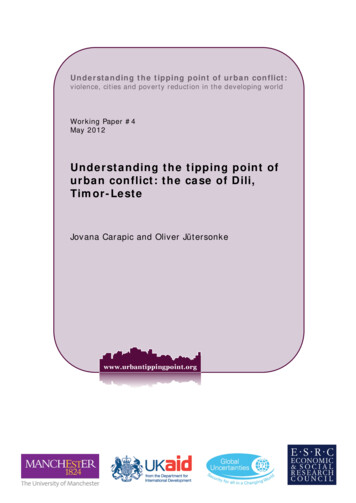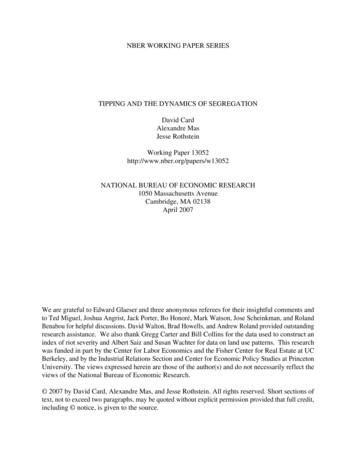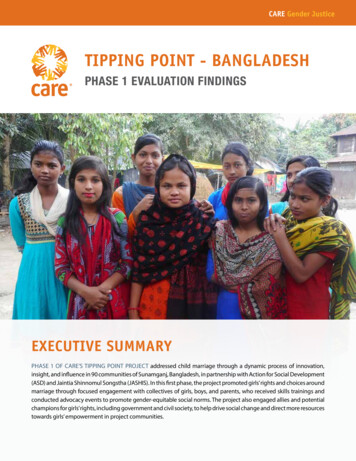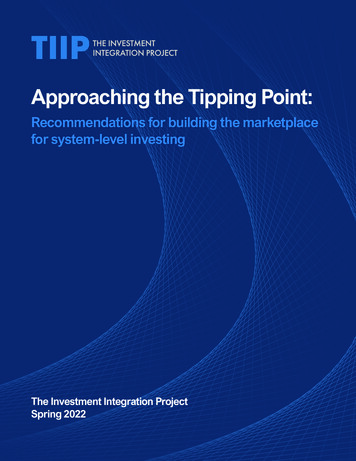
Transcription
Approaching the Tipping Point:Recommendations for building the marketplacefor system-level investingThe Investment Integration ProjectSpring 2022
DisclosuresHumanity United and UBS Optimus Foundation provided support for this research.Design and illustration for this document by April L. Smith. 2022 The Investment Integration Project (TIIP). All rights reserved.This paper is not intended as an offer, or a solicitation of an offer, to buy or sell anyinvestment or other specific product. Although all information and opinions expressedin this document were obtained from sources believed to be reliable and in goodfaith, no representation or warranty, express or implied, is made as to its accuracy orcompleteness. This document may not be reproduced, or copies circulated, withoutprior authority of the author. The author will not be liable for any claims or lawsuits fromany third parties arising from the use or distribution of this document. This document isfor distribution only under such circumstances as may be permitted by applicable law.
June 2022In 2020, against the backdrop of the Covid-19 pandemic, Humanity United, UBSOptimus Foundation and others launched Moving the Market (MtM), an initiative toshift investor considerations to include social impacts across asset classes. Through apooled fund, the initiative aimed to “move the market” by funding projects to supportinvestor demand for socially responsible investing and advanced approaches toaccounting for social impacts in investment decision-making.At the same time and given the extraordinary social andeconomic fallout caused by the Covid-19 pandemic, MtM alsosupported a parallel project to investigate the implications ofthe pandemic on investor decision making on systemic issues.Led by The Investment Integration Project (TIIP), the projectresulted in an assessment of how the pandemic affected thestructure of capital markets and identified ways to promotewidespread consideration of systemic issues in the financialindustry. This body of work built on TIIP’s near decade longeffort to help investors recognize the interconnection betweensocial, environmental, and financial systems, and shift thefinancial system from vulnerable to resilient, from extractiveto regenerative, and toward long-term sustainability – and toencourage them to adopt system-level investing.To build on growing interest by the financial industry inaddressing these systemic issues, TIIP, Humanity United,and UBS Optimus Foundation continued this partnershipto conduct a year-long Industry Needs Project that soughtto answer three fundamental questions: Do asset owners,intermediaries, and other financial industry stakeholdersunderstand what system-level investing is? Are they readyto adopt system-level investing approaches? What is thepath forward for the financial industry and toward industrytransformation?William BurckartCEOThe InvestmentIntegration ProjectMary ZiswilerDeputy CEOUBS OptimusFoundationThe “Approaching the Tipping Point: RecommendationsWaseem Mardinifor Building the Marketplace for System-level Investing”Managerroadmap is the result. The plan focuses on activities that canHumanity Unitedbe executed over the next two to five years to quickly equipthe financial industry with tools and strategies to manage existing systemic social andenvironmental challenges and drive broader industry transformation.
Industry transformation of the type envisioned here is a lofty goal, to be sure, and it willnot be easy. It will require a major cultural shift and the hard work and dedication of anentire ecosystem of champions for system-level investing – including thought leadersand experts on things like data, measurement, and regulation (e.g., fiduciary duty).Progress will likely be incremental at first. But the financial industry must at least try.We are approaching the tipping point. The long-term performance of investments andglobal well-being depend not only on it acknowledging systemic issues, but on it doingsomething about them.Mary ZiswilerWaseem MardiniCEODeputy CEOManagerThe InvestmentIntegration ProjectUBS OptimusFoundationHumanityUnitedWilliam Burckart
Table of contentsIntroduction1System-level Investing81.What is system-level investing? How is it different from conventional and sustainable investing?112. How do investors adopt system-level investing?123.15Why should investors adopt system-level investing?The State of the Industry1.16Knowledge of system-level investing172. Readiness to adopt system-level investing183.20Needed system-level investing supportThe Path Forward23 Phase 1: Awareness25 Phase 2: Adoption30Industry Leadership40Conclusion41Attachments43 Attachment A. Project focus group and interview respondents43 Attachment B. Project survey respondent summary45Acknowledgements46Notes47Boxes, Figures, and Tables Box 1. Early adoption of system-level investing4 Box 2. Systemic social issues are important too, really important10 Figure 1. Phases of industry evolution in the context of system-level investing3 Figure 2. The path forward for system-level investing6 Figure 3. Summary of findings from the industry needs assessment17 Figure 4. Common system-level investing roadblocks by stakeholder type19 Figure 5. System-level investing resource needs by stakeholder type21 Figure 6. Building the market for system-level investing24 Figure 7. The path forward for increasing awareness of system-level investing26 Figure 8. The path forward for enabling widespread adoption of system-level investing32 Table 1. Conventional vs. sustainable vs. system-level investing12 Table 2. Advanced system-level investing techniques14 Table 3. Organizations at the forefront of ESG data, monitoring, evaluation, and reporting34
IntroductionThe social and environmental challenges of the 21st century are new, different, andfundamentally destabilizing. Many of these challenges are systemic in nature; they arecomplex, interconnected global issues with multiple contributing factors. They impactentire economies and societies, threatening the global financial system and long-terminvestment returns across all asset classes.1Income inequality, for example, is stirring nationalistic protectionist sentiments,upending democracies, and inciting trade wars. Human rights abuses, includingmodern slavery and human trafficking, are triggering war and conflict, and weakeningsocieties. Systemic racism and sexism are stunting economic growth and fracturingsocial cohesion. Rapidly worsening climate change is accelerating natural disasters;these disasters are leading to mass migrations that threaten jobs and increaseexploitation of the women and girls that comprise a disproportionate percentage ofrefugees. Military invasions of sovereign democracies are displacing millions of peopleand endangering global food and energy supplies.More than ever before investors are adopting sustainable investing to manage the risksthat environmental and social challenges pose to investment, increase value over thelong term, and express their beliefs. They are increasingly recognizing the social andenvironmental impacts of specific investments, designing their portfolios accordingly,and seeking Environmental, Social, and Governance (ESG) benefits alongside financialreturn.According to the Global Sustainable Investment Alliance, nearly 36% of professionallymanaged assets across Europe, the United States, Japan, Canada, and Australasiawere invested using sustainable approaches (US 35.3 trillion) as of early 2020.2 Thisrepresents an increase of nearly 15% since 2018 and more than 55% since 2016 andincludes things like ESG integration, negative exclusionary screening, and shareholderaction. A growing number of investors are also signing on to the Principles forResponsible Investment (PRI), which guides them in managing ESG risks and usingsustainable investing to enhance returns. The number of PRI signatories has seensubstantial growth over the past 15 years – from 63 when it launched in 2006, to 1,501in 2016, to nearly 5,000 today.3While the growing adoption of sustainable investing is laudable, many existingsustainable investing approaches do not address the systemic nature of many oftoday’s most pressing social and environmental challenges. Such systemic challengesrequire system-level solutions, solutions like “system-level investing.” Systemlevel investing helps investors to manage the risks (and rewards) of the social,environmental, and financial systems that provide a stable, resilient foundation forinvestments across all asset classes. Introduction 1
It guides investors in understanding their impact on social, environmental, and financialsystems and in wielding their influence (and that of the collective financial community)to strengthen these underlying systems toward the goals of achieving competitivereturns in the short term, increasing value over the long term, and supporting globalsustainability.4 This differs from many sustainable investing approaches (e.g., ESGintegration and impact investing) that focus on environmental and social factors in somuch as they relate to the performance of specific companies or investments and notthat of broader systems.The financial industry is increasingly concerned about systemic challenges andinvestors are increasingly open to integrating system-level investing into theirinvestment practices. Notable financial industry leaders—including Hiro Mizuno (UnitedNations Special Envoy on Innovative Finance and Sustainable Investments [formerChief Investment Officer, Japan Government Pension Investment Fund]) and MarkCarney (Vice Chairman and Head of Impact Investing, Brookfield Asset Management[former governor, Bank of England])—have acknowledged the interconnection betweenglobal social, environmental, and financial systems.5Some of the world’s most influential asset owners—including the California StateTeachers’ Retirement System (CalSTRs), the Church of England Pensions Board, Guys’and St. Thomas’ Foundation, and UAW Retiree Medical Benefits Trust—have adoptedthe approach (see Box 1). The Investment Integration Project (TIIP) has spent the betterpart of the past decade providing thought leadership about system-level investing,developing commensurate theoretical frameworks, and providing “how to” guidanceto early adopters, forward-thinking investors, and industry associations in adopting theapproach.In recent years, organizations like the Predistribution Initiative, the CFA Institute, andThe Shareholder Commons have also begun specializing in various aspects of systemlevel investing.Further, events like the fallout from the ongoing Covid-19 pandemic—coupled withrecent racial reckonings around the world, the fear and uncertainty related to Russia’sinvasion of Ukraine, and ever-present and horrifying warnings about the irreversibleimpacts of climate change—have pushed discussions about the vulnerabilities andtipping points of interconnected global social, environmental, and financial systems tothe forefront of financial industry discourse.The acknowledgement of systemic interconnection by industry leaders, adoption ofsystem-level investing by notable investors, and the prevalence and confluence of aseries of major systemic challenges suggest that now is the time for industry-wideembrace of system-level investing.2Introduction
System-level investing: Approaching the tipping pointNotable industry leaders are speaking out about systemicchallenges and their interconnection with investment.Influential asset owners have adopted system-level investing– providing early case studies of the approach in action.TIIP and others have established theoretical frameworks forthe adoption of system-level investing.Current events (e.g., the Covid-19 pandemic, Russia’s invasionof Ukraine, and dire warnings about climate change) havepushed interconnected systemic challenges to the forefront ofindustry discourse.More specifically, it is time to accelerate system-level investing progress beyondits current phase of uncoordinated innovation—defined by a group of “disruptiveinnovators” executing “disparate entrepreneurial activities”—to formalize centers ofideas and activities and to develop a shard infrastructure for implementation of theapproach (marketplace building). Doing so will set the financial industry on a coursetoward capturing the value of the marketplace and, ultimately, maturity, ensuring that itcan manage systemic social and environmental challenges over time (see Figure 1).6Figure 1. Phases of industry evolution in the context of system-level gCapturing the valueof the marketplaceMaturityInvestors or smallgroups of investorsengaging indisparate (sometimesconflicting) systemlevel investmentactivitiesCenters ofsystem-levelinvesting ideasand activityand sharedinfastructure startto developSystem-level investingbecomes part ofmainstream investmentactivity; investors caneasily access neededinfastructure andsupportSystem-levelinvestingreaches arelativelysteady stateNote: Adapted from “Phases of industry evolution” introduced in Monitor Institute (2009). Investing for Social & Environmental Impact: ADesign for Catalyzing and Emerging Industry. Introduction 3
Box 1. Early adoption of system-level investingThe California State Teachers’ Retirement System (CalSTRS) (US 318.1 billion AUM). CalSTRShas asserted that climate change is a systemic risk and developed a multi-year, multi-asset class,internally managed Low-Carbon Index for passive equity management. It also co-leads ClimateAction 100 , an initiative of 700 investors (including some of the largest in the world) focused onpressuring the world’s biggest carbon-emitting corporations to reduce their carbon footprint, criticalto ensuring the global economy meets Paris Agreement goals. As of 2022, Climate Action 100 had gotten major companies the likes of Ford Motor Company, Duke Energy, BP, American Airlines,Dominion Energy, Unilver, Walmart, BASF, and Engie to agree to net zero carbon emissions orcarbon neutrality by 2050.The Church of England Pensions Board ( 3.7 billion AUM). In 2020, after several dams controlledby the Brazilian mining company Vale burst in the span of a few years, destroying nearby towns,and killing over 250 workers and residents, the Pensions Board, which owns stock in Vale, createda coalition of investors to demand new global safety standards in the mining industry, to beenforced by an independent body. As a result, Vale and other global mining companies agreedto undertake annual audits of their dams, implement new safety standards, and commit to publicreporting – and, in doing so, improved the overall health of the mining industry in Brazil and thesocial and financial systems that that industry contributes to.Guys’ & St. Thomas’ Foundation ( 600 million AUM). The Foundation has started investing itsendowment in line with its mission to improve health and well-being in the UK, recognizing thatrelying on grantmaking alone would be insufficient to achieve its goals. This includes, for example,the foundation’s investment in SMASH app (Save Money and Stay Healthy) in 2020. SMASH gives13-to-24-year-olds a 20% discount on healthy food options at food-to-go retailers (e.g., fast foodrestaurants) with the goal of reducing childhood obesity and improving health. If successful, thesolution could be scaled through a similar 20% Value-added tax (VAT) reduction in healthy foods.The foundation also partners with ShareAction to encourage investors to consider health andits underlying social factors in investment decision making through the Long-term Investors forPeople’s Health program. The program encourages shareholder action like the recent resolutionaimed at Tesco to encourage the company to sell more healthy food. The Foundation’s commitmentto improving health across the UK via a diversity of approaches aims to improve broader healthsystems of the country.UAW Retirees Medical Benefits Trust (US 63 billion AUM). UAW advocates for morecomprehensive standards and data disclosure around income inequality. The Trust houses theHuman Capital Management Coalition (HCMC), which is supported by 32 institutional investors withUS 6 trillion in assets under management. In 2020, the US Securities and Exchange Commission(SEC) amended its rules for how public companies disclose workforce information in response to apetition filed by the HCMC in 2017. UAW also co-chairs the Investors for Opioid and PharmaceuticalAccountability (IOPA), which engages with opioid manufacturers, distributors, and retail pharmacieson opioid business risks that have implications for long-term shareholders, communities, andthe economy. By the end of 2020, the IOPA had gotten 15 companies – including eight opioidmanufacturers and three major opioid distributors – to submit or commit to submitting oversightreports. UAW’s efforts to work across entire industries – and not just with individual companies –aim to improve various components of the broader social system in the US.4Introduction
What does the financial industry need to build the marketplace forsystem-level investing and support widespread adoption of the approach?With funding from Humanity United and UBS Optimus Foundation, The InvestmentIntegration Project (TIIP) launched The Industry Needs Project to identify where thefinancial industry is vis-à-vis system-level investing and to provide the industry with acommensurate path forward. For the first part of the two-part project, TIIP conductedan industry needs assessment that included an examination of financial industrystakeholders’ concerns about systemic social and environmental issues, awarenessof system-level investing, readiness to adopt the approach, roadblocks to doing so,and need for related information and support. For the second part of the project, TIIPused the findings from the industry needs assessment to develop a plan to build themarketplace for system-level investing and encourage widespread adoption of theapproach toward the ultimate goal of industry transformation.After first providing a brief primer on system-level investing (System-level Investing),the remainder of this report summarizes the findings from the industry needsassessment (The State of the Industry) and outlines ways that the financial industrycan formalize centers of ideas and activities and develop a shared infrastructure forimplementation of the approach that supports a higher volume of activity; that is,a plan for building the marketplace for system-level investing (The Path Forward).It also offers initial ideas for capturing the value of the marketplace to help ensurethat system-level investing becomes part of mainstream investment activity and thatinvestors can easily access needed infrastructure and support.The plan focuses on activities that can be executed over the next two to five yearsto quickly equip the financial industry with tools and strategies to manage existingsystemic social and environmental challenges. The first phase of the plan – awareness– focuses on increasing awareness about system-level investing and systemicissues and, when possible, suggests ways to build on work already done or currentlyunderway by TIIP and others to help investors understand the what, why, and how ofsystem-level investing. The second phase – adoption – focuses on fortifying industrystructures to facilitate the widespread adoption of system-level investing, whichincludes considering topics like data, evaluation, and regulation: topics for which muchprogress has been made related to sustainable investing but for which the financialindustry faces more questions than answers in terms of system-level investing. Figure2 below summarizes the goals and activities associated with these two phases.Corresponding figures later in the report (in The Path Forward) provide additionaldetails about how each phase responds to specific needs identified in the research. Introduction 5
Figure 2. The path forward for system-level investingPhase 2: AdoptionPhase 1: AwarenessGoalsIncrease awareness about system-level investing and systemic issues to support investors’adoption of the approach12312Ensure that investorsunderstand what makes anissue systemic, and whatsystem-level investingis and is not (providedefinitional clarity) and whythey should adopt itEmpower investors tostart integrating systemlevel investing into theirinvestment practicesto increase adoption ofsystem-level investingFacilitate opportunitiesfor collaboration and peerexchange to improveand otherwise advanceadoption of system-levelinvestingDevelop standardizedsystems for monitoring,evaluating, andreporting on investors’impacts on systemicissuesAdvocate for changesto global regulatoryframeworks to ensurethat they do not impede– and in fact support –widespread adoption ofsystem-level investingDevelop and provideinvestors with easy-to-useplug-and-play toolkits,guides, and templates tosupport successful adoptionof system-level investing –including information abouthow to adapt conventionalapproaches and adoptadvanced techniques topurse system-level goalsBuild a system-levelinvesting community ofpractice that facilitatesinteractive discussions andthe productive exchange ofideas and best practicesExamine available ESG dataand existing monitoring,evaluation, and reportingframeworks; determinewhether and how investorscan adapt them to measuretheir impacts on systemicissues and progress towardsystem-level goalsNext stepsCurate existing resources onthe what and why of systemlevel investingAdapt and amend existingresources so that they areclear, concise, and reflectindustry consensus relatedto system-level investingDisseminate and otherwiseamplify information aboutsystem-level investing6IntroductionFortify industry structures to enable widespread adoption ofsystem-level investingPressure regulators to makechanges to global regulatoryframeworks to ensure thatthey support widespreadadoption of system-levelinvestingAssemble a workinggroup to recommend astandardized system formonitoring, evaluating, andreporting investors’ impactson systemic issues
Industry transformation will not happen overnight and no one entity can build themarketplace for system-level investing alone. Doing so will require the hard workand dedication of an entire ecosystem of champions for system-level investing –including thought leaders and experts on things like data, measurement, fiduciary duty,evaluation, and marketing (among others) – and progress will likely be incremental atfirst.The Path Forward details two sequential phases and a series of related activities, someof which can usefully build on the existing body of work on system-level investing orefforts currently underway, and others of which represent new and relatively unchartedterritory. It suggests first targeting asset owners with long-term interests (e.g., pensionfunds, foundations, endowments, family offices, insurance companies, and sovereignwealth funds) – building demand for the approach among influential institutionalinvestors to incentivize intermediaries (e.g., asset managers, financial advisors, andconsultants) to follow suit.Industry transformation is a lofty goal to be sure, and it will not be easy. But thefinancial industry must at least try – it cannot afford not to. We are approaching thetipping point. The industry’s long-term survival and global well-being depend not onlyon the financial industry acknowledging systemic issues, but on it doing somethingabout them. Introduction 7
System-level InvestingFinance and investment are built on the predictability and reliability of society, thefinancial system, and the environment. Stable systems enable healthy markets;unstable systems lead to reduced or negative market returns. The systems thatunderpin the market are the greatest source of overall absolute performance forinvestors: all investors benefit from the performance of the overall market, driven bythe performance of the economy.7 The decisions of investors as market participantshave economy-wide implications, drive the movement of benchmark indexes, andimpact the fate of these systems (whether they recognize it or not).Systemic challenges are complex, interconnected, and fundamentally destabilizing.They have multiple contributing factors, impact entire economies and societies,and threaten the entire financial system and long-term investment returns across allasset classes. They include, for example, income inequality, consumer health andsafety, human rights, social equity and diversity, climate change, biodiversity, naturalresources and sustainable land use, shareholder rights, and market transparency. Ofcourse, investors should care about all these issues for ethical reasons, but investorsare particularly well-suited to manage a subset of systemic issues that conform to thefollowing criteria:8 Consensus. There is broad consensus as to the legitimacy and generalimportance of the issue among a wide range of credible stakeholders, and broadconsensus as to whether the issue relates to a public good that supports privateactivities. Relevance. The issue has substantial potential to impact positively or negatively(is relevant to) the long-term financial performance of investors’ portfolios acrossindustries and asset classes. Effectiveness. Investors can effectively impact the system and its ability toprovide a common public good and support private activities. Uncertainty. There is uncertainty as to the nature and extent of the risks oropportunity costs related to the challenge.Climate change is the systemic issue atop of many investors’ minds, and for goodreason. Climate change and its related challenges could reduce global GDP by asmuch as 14% by 2050 should average temperatures rise by 2.6 degrees Celsius, andby as much as 18% if temperatures rise by 3.2 degrees Celsius.9 Further, a recentFinancial Stability Board report estimates that an average temperature rise of 2degrees Celsius could reduce global financial asset values between 0.7% and 4.2%.8System-level Investing
This says nothing of the humanitarian toll of climate change and related extremeweather events, including increased respiratory disease and changes in theprevalence and geographical distribution of food- and water-borne illnesses and otherinfectious diseases.10 But while climate change is certainly very important, there aremany systemic social challenges that are inextricably connected to climate changethat require investors’ attention (see Box 2). System-level Investing 9
Box 2. Systemic social issues are important too, really importantIncome inequality and forced labor are just two of the many systemic social issues thatcan impact investment returns across all asset classes.Income inequality. Income (and wealth) inequality—both between and within countries—issubstantial. The world’s richest 10% of people currently earn 52% of global income while thepoorest 50% earn just 8% of global income. In the U.S., the richest 10% captures 45.5% oftotal income while just 13.3% goes to the bottom 50%. Corporate and government policiesand practices that enrich shareholders and marginalize workers (e.g., stock buybacks, taxevasion, fissuring, limitations on collective bargaining) are in large part to blame for thesestatistics. And although some degree of income inequality can serve as an incentive topromote hard work, the extreme income inequality that exists within and across countriestoday contributes to: (a) slowed economic growth; (b) limited upward mobility and laborforce participation; and (c) social unrest and political dysfunction.Income inequality is not just bad for individual people and countries; it harms global wellbeing and disrupts interconnected global economic, social, and political systems. Investorsacross all asset classes depend on the health of these systems to ensure the smoothfunctioning of financial markets and, ultimately, support returns. When income inequalityleads to one or more of the consequences identified above, investments can suffer.Forced labor. On any given day, approximately 25 million people (mostly women and girls)are victims of forced labor, one of the primary forms of modern slavery– working underthreat or coercion across nearly every corporate sector to produce goods and servicesthat end up in “legitimate commercial channels” (e.g., agriculture, apparel, construction,electronics). Beyond the obvious ethical concerns posed by forced labor, the practiceprecludes consumers and investors from knowing the true cost of producing a good orservice which, in turn, results in incorrect pricing and corporate valuations. The many andcomplex drivers of the issue and its underlying causes – including, for example, exploitativeextractive capitalism and migration resulting from war and conflict, poverty, and climatechange – and its global prevalence make forced labor an issue that investors cannotdiversify away.10System-level Investing
1. What is system-level investing? How is it different fromconventional and sustainable investing?System-level investing is an investment approach centered on adapting both existing,conventional investment techniques and utilizing new tools to manage the risks andrewards of the social, environmental, and financial systems that provide a stable,resilient foundation for investments across all asset classes. Using these techniquesand tools, investors—be they institutions, families, or individuals—can better recognizethe scope and scale of their impact and influence on social, environmental, andfinancial systems, and intentionally manage this impact toward the goals of:11Minimizing long-termsystemic risks;Capitalizing on relatedopportunities for longterm value creation; andBuilding resilient systemsthat support investmentsacross all asset classes.Investors adopt system-level investing and pursue these goals alongside their ongo
The "Approaching the Tipping Point: Recommendations for Building the Marketplace for System-level Investing" roadmap is the result. The plan focuses on activities that can be executed over the next two to five years to quickly equip the financial industry with tools and strategies to manage existing systemic social and

